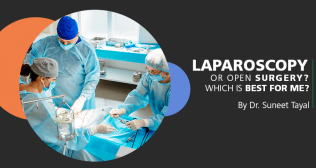
Obstetrics and Gynaecology
Hysteroscopy: A Boon For Women'S Health
Dr. Neena Bahl Jul 18, 2014
 A hysteroscopy is used to remove growth of fibroids or polyps in the uterus. It may be done to see if a problem in your uterus is preventing you from becoming pregnant
Menstrual problems have troubled women since ages. Every month the lining of the uterus (womb) is shed as menstruation. In some cases, there is too much build-up of the lining or there is a small growth (polyp/ fibroid) or thinning of the lining of the womb which can give troublesome symptoms like heavy or scanty periods or bleeding in between periods. In the past, these problems were diagnosed and treated with a procedure called dilatation or curettage (also called D&C). But modern gynaecology has moved on to a procedure called Hysteroscopy (hystero – womb + scopy – visualising). It is a procedure to examine the inside of the uterus.
1. Scope
2. Pelvic bone
3. Bladder
4. Uterus
5. Anus
It is carried out using a hysteroscope, which is a narrow tube with a telescope at the end and connected to a TV screen which shows a magnified view of the womb, so even very small abnormalities such as a tiny 1 mm polyp or growth is not missed. This helps the surgeon to take a biopsy directly from the problem area instead of taking it blindly.
This procedure that is often carried out as a day care procedure, which means you do not have to stay in hospital overnight. It can be performed under local anaesthesia (when medication is used to numb a small area) or general anaesthesia (when you are asleep, the surgeon will insert the hysteroscope through the cervix, into the womb), under the supervision of an anaesthesia doctor or anaesthesiologist, and gas or
fluid is often used to inflate the womb, to give the surgeon a better view.
It takes no more than 10-30 minutes, depending on what needs to be done.
This can be used to diagnose cases when a woman’s symptoms suggest there could be a problem with her womb. Symptoms can include:
• Heavy periods or irregular periods
• Bleeding between normal periods, after sexual intercourse or after menopause
• Pelvic pain
• Unusual vaginal discharge
• Repeated miscarriage
• Infertility
A hysteroscopy can also be used to remove abnormal growth from the womb, such as:
• Fibroids: Non-cancerous growths that can develop inside the womb and can sometimes cause symptoms such as pain and heavy periods.
• Polyps: Small growth that develop on the lining of the womb and can cause irregular and heavy periods.
• Intrauterine adhesions: Sections of scar tissue that can cause absent periods and infertility.
• Thickening of the uterus’ lining: This can increase the risk of womb cancer
A hysteroscopy is used to remove growth of fibroids or polyps in the uterus. It may be done to see if a problem in your uterus is preventing you from becoming pregnant
Menstrual problems have troubled women since ages. Every month the lining of the uterus (womb) is shed as menstruation. In some cases, there is too much build-up of the lining or there is a small growth (polyp/ fibroid) or thinning of the lining of the womb which can give troublesome symptoms like heavy or scanty periods or bleeding in between periods. In the past, these problems were diagnosed and treated with a procedure called dilatation or curettage (also called D&C). But modern gynaecology has moved on to a procedure called Hysteroscopy (hystero – womb + scopy – visualising). It is a procedure to examine the inside of the uterus.
1. Scope
2. Pelvic bone
3. Bladder
4. Uterus
5. Anus
It is carried out using a hysteroscope, which is a narrow tube with a telescope at the end and connected to a TV screen which shows a magnified view of the womb, so even very small abnormalities such as a tiny 1 mm polyp or growth is not missed. This helps the surgeon to take a biopsy directly from the problem area instead of taking it blindly.
This procedure that is often carried out as a day care procedure, which means you do not have to stay in hospital overnight. It can be performed under local anaesthesia (when medication is used to numb a small area) or general anaesthesia (when you are asleep, the surgeon will insert the hysteroscope through the cervix, into the womb), under the supervision of an anaesthesia doctor or anaesthesiologist, and gas or
fluid is often used to inflate the womb, to give the surgeon a better view.
It takes no more than 10-30 minutes, depending on what needs to be done.
This can be used to diagnose cases when a woman’s symptoms suggest there could be a problem with her womb. Symptoms can include:
• Heavy periods or irregular periods
• Bleeding between normal periods, after sexual intercourse or after menopause
• Pelvic pain
• Unusual vaginal discharge
• Repeated miscarriage
• Infertility
A hysteroscopy can also be used to remove abnormal growth from the womb, such as:
• Fibroids: Non-cancerous growths that can develop inside the womb and can sometimes cause symptoms such as pain and heavy periods.
• Polyps: Small growth that develop on the lining of the womb and can cause irregular and heavy periods.
• Intrauterine adhesions: Sections of scar tissue that can cause absent periods and infertility.
• Thickening of the uterus’ lining: This can increase the risk of womb cancer Categories
Clear allMeet the doctor

Dr. Neena Bahl
SENIOR DIRECTOR OBSTETRICS & GYNAECOLOGY | Fortis La Femme GK
- Obstetrics and Gynaecology | Obstetrics and Gynaecology
-
35 Years
-
2000



















